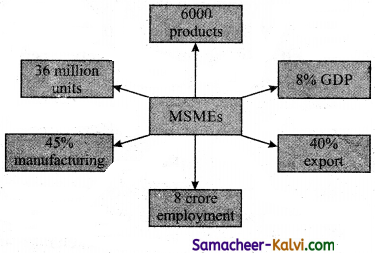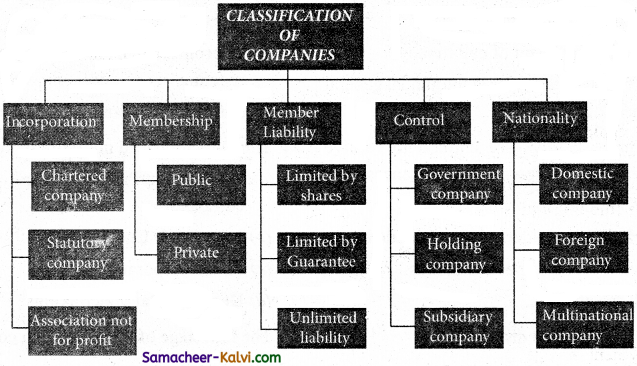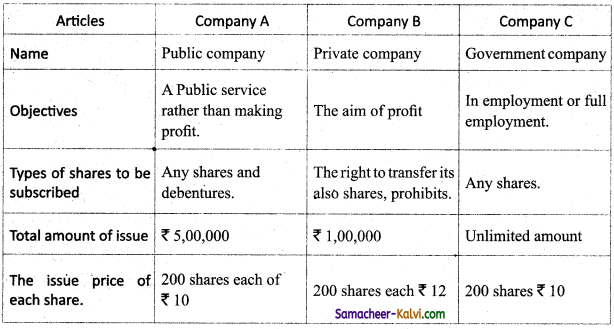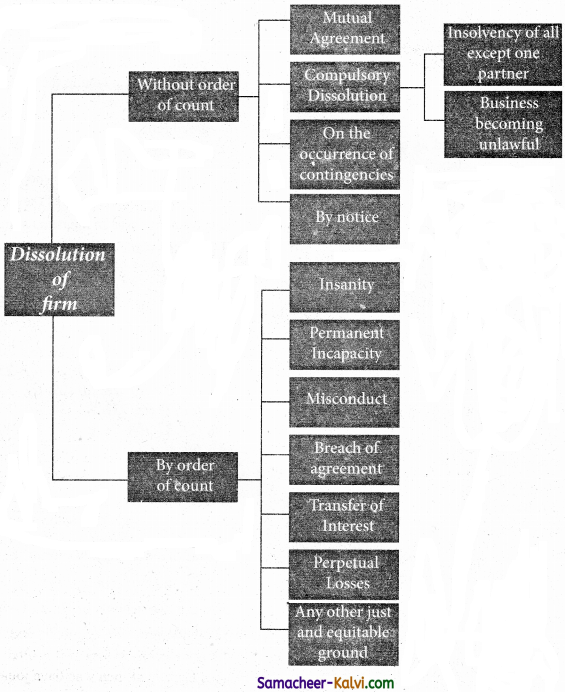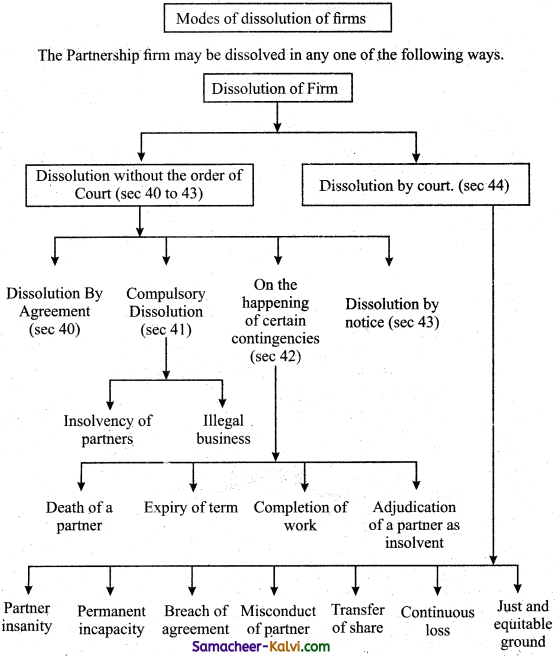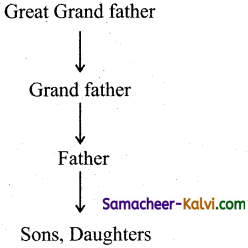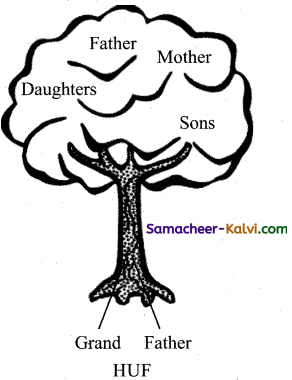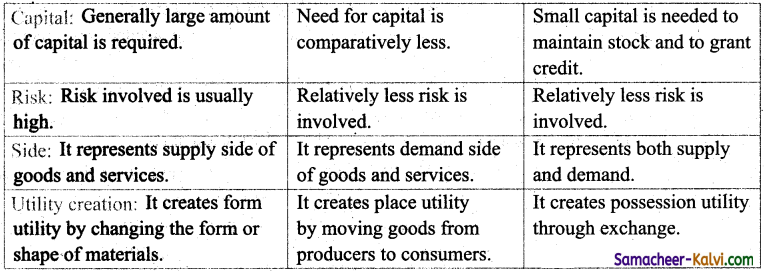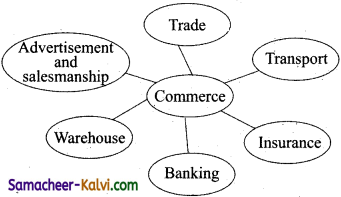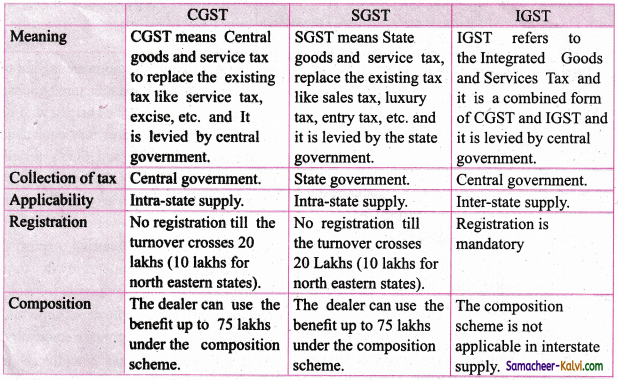TN State Board 11th Commerce Important Questions Chapter 30 Performance of Contract
Question 1.
State the ways of performing a Contract.
Answer:
There are mainly two ways of performing a contract. They are-
- Actual Performance and
- Attempted performance.
Question 2.
Who is a Legal Representative?
Answer:
- If the promisor dies, the legal representative of the deceased promisor is bound to perform the contract, (section-37).
eg: Mr. Raja promises to sell his car for ₹ 5,00,000 to Kannan after a week. - But Raja dies after 5 days of the contract ’ Raja’s representative will be liable to sell the car to Kannan.
- Kannan will be liable to pay ₹ 5,00,000 to Raja’s representative.
![]()
Question 3.
Who is an agent?
Answer:
According to Para 2 of Section 40, the promisor may employ a competent person such as agent to perform the promise, if the contract is not formed on personal condition.
Question 4.
Define Reciprocal Promise.
Answer:
- According to Section 2 (f) of the Indian contract Act 1872 as defines reciprocal promise.
- Promises which form consideration or part – of consideration for each other are called ‘reciprocal promise’.
Question 5.
By whom must contracts be performed?
Answer:
The contract may be performed by the following persons.
- The promisor himself.
- The agent.
- The legal representative.
- The third person.
- The joint promisor.
![]()
Question 6.
What is a Valid tender?
Answer:
A tender is an offer to do or perform an act which the party offering is bound to perform to’ the party to whom the offer is made. A tender may be of money or of specific articles these will be separately considered. of the lender of money to make a valid tender the following requisites are necessary.
Question 7.
Who can execute and Perform a Contract?
Answer:
(i) Promisor himself:
The contract must be performed by the promisor himself or by his legal representatives, or by any other competent person employed by him then such promise must be performed by the promisor himself Or by his legal representatives or by an other competent person employed by him.
(ii) Agent:
An agent is appointed by the promisor for the purpose of perform a contract.
(iii) Representations:
If the promisor dies. Of course in case of other contracts, the legal representatives of a deceased promisor are bound to perform the contract sec.37.
![]()
Question 8.
Who can demand performance?
Answer:
The following are those who can demand the performance of a valid contract.
(i) Promisee:
Only a promisee can demand performance and not a stranger demand performance of the contract.
(ii) Legal representative:
Legal representative can demand Exception performance. Contrary intention appears from the contract. Contract is of a personal nature.
(iii)Third party:
‘Exception to “Stranger to a contract”.
Question 9.
Write a note on the benefits of Reciprocal Promise.
Answer:
(i) Mutual and Independent:
Where each party must perform his promise independently without the performance of the other, the promise are mutual and independent, eg: Ramu agrees to pay Somu the amount for the rice supplied on 10th June. Somu promises to deliver rice on 18th June.
(ii) Mutual and Dependent:
Where the performance of the promise by one party depends upon prior performance of promise by the other party, the promises are conditional and dependent, eg: A agrees to construct a building for B. B agrees to supply cement for the construction. Hence A’s promise to perform depends on B’s promis
(iii) Mutual and Concurrent:
Where the two promises are said to be performed simultaneously, they are said to be mutual and concurrent.
![]()
Question 10.
Who is a Joint Promisors?
Answer:
Section.42 of Indian Contract Act lays down that “When two or more persons have made a joint promise, then unless a contrary intention appears in the contract, all, such persons, during their joint lives and after the death of the last survivor, representatives of all, jointly must fulfil the promise”.
Question 11.
Explain rules relating to place of performance of promise.
Answer:
(i) Under Section 46:
Performance within a reasonable time: According to Section 46, a promisor is to perform his promise within a reasonable time. On the other hand, reasonable time will depend upon the circumstance of the case, the usage of trade or on the intention of the parties entering into the contract.
(ii) Under Section 47:
Specified time and place for performance: If the promise is to, be performed on a certain day, the promisor may undertake to perform it without application of the promisee. According to the Section 47, In such a case the promisor may perform the promise at any time during the usual hours of business on such day and at the place at which the promise ought to be performed.
(in) Under Section 48:
Performance on a certain day: If the promise is to be performed on a certain day the promisor may undertake to perform it after the application by the promisee to that effect.
(iv) Under Section 49:
Performance of promise when no place is fixed and without application: If the promise is to be performed without application by the promisee and where no place is mentioned to be performed of tlhe contract then it is the duty of the promisor to apply to the promisee to provide a reasonable place for the performance of the promise and to perform it at such place.
![]()
Question 12.
Elucidate the provision regarding time as factor in performance.
Answer:
(i) Under Section 46, performance within a reasonable time:
According to Section 46, a promisor is to perform his promise within a reasonable time. On the other hand, reasonable time will depend upon the circumstance of the case, the usage of trade or on the intention of the parties entering into the contract.
eg: A has given an order of supply of books in July which should be performed within 4 to 5 days of the month of July.
(ii) Under Section 47, specified time and place for performance:
If the promise is to be performed on a certain day, the promisor may undertake to perform it without application of the promisee. According to the Section 47, In such a case the promisor may perform the promise at any time during the usual hours of business on such day and at the place at which the promise ought to be performed.
(iii) Under Section 48, performance on a certain day:
If the promise is to be performed on a certain day the promisor may undertake to perform it after the application by the promisee to that effect.
(iv) Under Section 49, performance of promise when no place is fixed and without application:
If the promise is to be performed without application by the promisee and where no place is mentioned to be performed of the contract then it is the duty of the promisor to apply to the promisee to provide a reasonable place for the performance of the promise and to perform it at such place.
eg: M takes to deliver 1,000 kilos of wheat to N on a fixed day. M must apply to appoint a reasonable place for the purpose of receiving it and must deliver it to him at such place.
(v) Under Section 50, performance is prescribed by the promisee:
According to Section 50, the performance of any promise may be made in any manner or at any time which the promisee prescribes.
eg: T owes S ₹ 2,00,000/- to accept T’s car value of ₹ 1,00,000/- in reduction of the debt. The delivery of the car will amount to a part payment of the debt.
![]()
Question 13.
How do you think appropriation of payments takes place?
Answer:
‘Appropriation means application of payments – The question of appropriation of payments arises when a debtor owes several debts to the same creditor and makes a payment that is not sufficient to discharge the whole indebtedness.
(i) Appropriation of Payments:
Sometimes, a debtor owes several distinct debts to the same creditor and he makes a payment which is insufficient to satisfy all the debts. In such a case, a question arises as to which particular debt the payment is to be appropriated. Section 59 to 61 of the Act lay down following rules as to appropriation of payments which provide an answer to this question.
(ii) Appropriation as Per express Instructions:
Every debtor who owes several debts to a creditor has a right to instruct his creditor to which particular debt, the payment is to be appropriated or adjusted. Therefore, where the debtor expressly states that the payment is to be applied to the discharge of a. particular debt, the payment must be applied accordingly.
eg: X owes Y three distinct debts of ₹ 20,000, ₹ 30,000 and ₹ 50,000 X sends ₹ 50,000 and instructs Y that the payment should be appropriated against the third debt. He is bound to appropriate the payment against the third debt only.
(iii) Application of payment where debt to be discharge is not indicated [60] :
If section 60 is attracted, the creditor shall have the discretion to apply such payment for any lawful debt which is due to him from the person making the payment.
eg: P owes to Q, among other debts, the sum of ₹ 10,000. Q writes to P and demands payment of this sum. P sends to Q ₹ 10,000. This payment is to be applied to the discharge of the debt of which Q had demanded payment.
(iv) Application of payment where neither party appropriates [61]:
The payment shall be applied in discharge of the debts in order of time whether they are or are not based by the limitation Act 1963, if the debt are of equal standing (i.e. payable on the same date) the payment shall be applied in discharge of each of these debt proportionately.
Question 14.
To identify the performance and distinguish the performance as actual or attempted.
Answer:
- When the party has done what he had undertaken to do. It is called actual performance.
- When the party offers to perform his obligation. Itisnotacceptedbythepromisee, so it is called offer to performance.
![]()
Question 15.
To understand the time and place of performance, so that the contract is established to be discharged or not.
Answer:
- If the promise is to be performed on a certain day, the promisor may undertake the perform it without application of promise.
- However, the promise should be performed at the place where it was required to be performed.
Question 16.
Suggest ways by which the nature of performance of a contract can be categorised.
Answer:
- Apromisor is to perform his promise within a reasonable time.
- On the other hand, reasonable time will depend upon the circumstances of the case.
Question 17.
To identify those who are involved in the process of performance of contract and their legal status.
Answer:
- The contract should be performed by the promisor by himself. He is like a legal representative.
- Contract which are not of personal nature may be performed by an agent who is likely a promisor.
![]()
Choose the Correct Answer:
Question 1.
On the validperformance of the contractual obligations by the parties, the contract:
(a) is discharged
(b) become enforceable
(c) becomes void
(d) becomes legal
Answer:
(a) is discharged
Question 2.
Which of the following persons can perform the contract?
(a) Promisor alone
(b) Legal representatives of promisor
(c) Agent of the promisor
(d) All the above
Answer:
(d) All the above
Question 3.
A, B, C jointly promised to pay ₹ 50,000 to D. Before performance of the contract, C dies. Here, the contract:
(a) becomes void on C’s death
(b) should be performed by A and B along with C’s legal representatives.
(c) should be performed by A and B alone.
(d) should be renewed between A, B and D.
Answer:
(b) should be performed by A and B along with C’s legal representatives.
![]()
Question 4.
Which of these parties cannot demand performance of promise?
(a) Promisee
(b) Any of the Joint Promisees
(c) On the death of a Promisee, his Legal Representative.
(d) Stranger to the Contract
Answer:
(d) Stranger to the Contract
Question 5.
A person is said to be a third person if he is hot a:
(a) promisor
(b) promise
(c) agent
(d) Legal Representative
Answer:
(c) agent
![]()
Samacheer Kalvi 11th Commerce Notes Chapter 30 Performance of Contract
→ Regarding the performance of contract, section 37 of the act states that the parties to a contract must be either.
(i) Perform their respective promises of
(ii) Offer to perform the same
(iii) Such performance is dispensed with or
(iv) Excused under the provisions of the act or of any other law.
→ There are mainly two ways of performing a contract such as actual performance, attempted performance. Who will perform the contract?
(i) Promiser himself
(ii) Agent
(iii) Representations
(iv) Third parties
(v) Joint promisors
To explain about the devolution of joint rights and joint liabilities.
→ Joint rights:
“When a person has made a promise to two or more persons jointly, then unless there is a contract to the contrary, the right to claim performance rests as between him and them. With them during their joint lives, and after the death of them with representatives of such deceased person jointly with survivors and after the death of last survivor, with the representatives of all jointly.”
→ Devolution of joint liabilities:
Section 42 of Indian contract act lays down that “when two or more persons have made a joint promise, then unless a contrary intention appears in the contract, all such persons, during the joint lives and after the death of the last survivor, representatives of all jointly must fulfil the promise.
